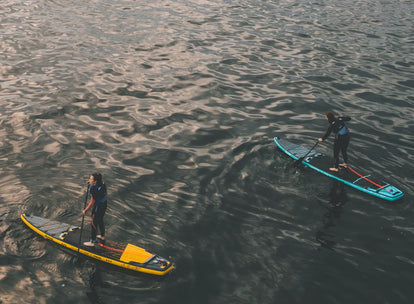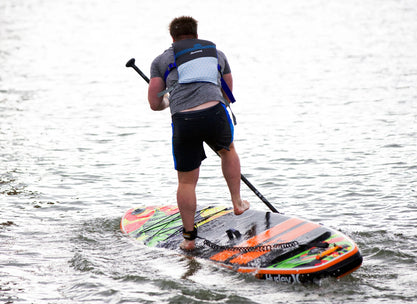The appeal of paddle board yoga lies in the integration of yoga, nature and adventure. It offers a unique and refreshing way to practice yoga, combining physical challenges, mindfulness, and a deep connection to the natural surroundings.
It can feel like a bit of a surreal experience the first time you do it. It’s probably unlike anything you’ve ever done before – not to mention the added peril of taking a dip in the water if you lose your balance – which is quite possible as the water will not lie still for anyone! So, if you prepare for your practice to include a dunk, you can only be pleasantly surprised with an even bigger inner glow!
Whether you're a yoga enthusiast or simply seeking a new and exciting way to connect with yourself and nature, paddle board yoga provides a fulfilling and memorable experience.
If you're intrigued by this fusion practice, here are some essential tips to help you get started with paddle board yoga:
Choose the right equipment

To begin with paddle board yoga, you'll need the right equipment. Invest in a stable and durable paddle board designed for yoga, typically wider, thicker, and more stable than traditional paddle boards. Look for one with a larger non-slip deck pad for added traction.
We’ve got a whole selection of inflatable boards that are perfect for yoga.
Additionally, choose an adjustable paddle that suits your height, allowing for a comfortable and efficient stroke. Once you’ve done your workout, you might want to get back to the water’s edge as quickly as possible for a little lie down.
Find a suitable location

Selecting an appropriate location is crucial for your paddle board yoga practice. To give yourself half a chance of staying upright on your board, opt for calm and flat water, such as the canal, lake, pond or a still section of the ocean, to minimise the impact of waves and currents.
Ensure there is ample space around you to avoid obstacles and other watercraft. Personally, I’d choose deeper water over very shallow to prevent injury should you topple in.
Research local regulations and any permits required for paddle boarding in your chosen area. There’s nothing like getting a telling off from a local official to bring you out of your mindfulness state…
Start with basic SUP skills

Before attempting yoga poses on your paddle board, familiarise yourself with basic stand-up paddleboarding (SUP) skills. Practice paddling in a straight line, turning and maintaining balance while kneeling and standing on the board.
If you can prop your board up on cushions or similar (to prevent damaging the fins or carpet) practice at home first. This will help you build confidence and stability for on the water, making the transition to yoga poses smoother.
Begin with gentle and basic yoga poses

As a beginner, start with gentle and basic yoga poses that are suitable for the paddle board. Focus on postures that promote balance, stability and grounding. Examples include Mountain Pose (Tadasana), Shoulder Bridge Pose (Etu Bandha Sarvangasana pose), Downward Facing Dog (Adho Mukha Svanasana) and Child's Pose (Balasana). There are even great practices to be had by moving smoothly and on the breath from one pose to another. All these poses can be progressed (made more difficult) for those yogi experts amongst us or modified (made easier) as needed to accommodate the movement of the board and the challenge of balancing on water.
If you’re a little unsure on where to start, there are some great paddleboard yoga instructors out there that can provide the guidance you need, so it doesn’t just feel like you’re making it up as you go along!
Embrace the water and enjoy the experience

Allow yourself to adapt and adjust to the movement of the board, finding your balance with each breath. Be prepared to fall in and have a sense of humour about it. If you’re not prepared to get wet from time to time, you might as well just do a different type of yoga instead.
Remember that it's not about achieving perfection but rather embracing the journey and enjoying the experience. Sharing the experience with others who appreciate the beauty of nature and the practice of yoga can create a supportive and uplifting environment.
Go on, give it a go!


